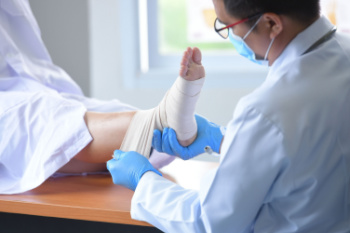
Kevin F Gallagher, DPM
Board Certified in Foot and Ankle Surgery
(724) 941-4330

Kevin F Gallagher, DPM
Board Certified in Foot and Ankle Surgery
(724) 941-4330

Yoga can significantly enhance circulation, promoting better blood flow and overall health. Specific poses, like the headstand, legs up the wall, and head-to-knee pose, are particularly beneficial. The headstand pose helps improve circulation by reversing the effects of gravity, encouraging blood flow to the upper body and brain. Legs up the wall pose aids in reducing swelling and fatigue by allowing blood to flow back toward the heart, which is especially helpful for those who spend long periods sitting or standing. The head-to-knee pose stretches the hamstrings and stimulates blood flow to the lower extremities, improving flexibility and circulation. Regular practice of these poses can help alleviate symptoms of poor circulation, such as swelling and cold feet, by enhancing blood flow and promoting overall vascular health. If you have symptoms of poor circulation in your feet that can include tingling sensations or discoloration, it is suggested that you consult a podiatrist who can discuss specific yoga poses and other stretches for possible relief.
While poor circulation itself isn’t a condition; it is a symptom of another underlying health condition you may have. If you have any concerns with poor circulation in your feet contact Dr. Kevin F. Gallagher of Gallagher Podiatry. Our doctor will treat your foot and ankle needs.
Poor Circulation in the Feet
Peripheral artery disease (PAD) can potentially lead to poor circulation in the lower extremities. PAD is a condition that causes the blood vessels and arteries to narrow. In a linked condition called atherosclerosis, the arteries stiffen up due to a buildup of plaque in the arteries and blood vessels. These two conditions can cause a decrease in the amount of blood that flows to your extremities, therefore resulting in pain.
Symptoms
Some of the most common symptoms of poor circulation are:
Treatment for poor circulation often depends on the underlying condition that causes it. Methods for treatment may include insulin for diabetes, special exercise programs, surgery for varicose veins, or compression socks for swollen legs.
As always, see a podiatrist as he or she will assist in finding a regimen that suits you. A podiatrist can also prescribe you any needed medication.
If you have any questions, please feel free to contact one of our offices located in McMurray and Hickory, PA . We offer the newest diagnostic and treatment technologies for all your foot care needs.

Ankle injuries can range from minor sprains to severe fractures. Broken ankles, or fractures, typically involve one or more of the three bones that make up the ankle joint. Specifically, they are the tibia and fibula in the leg, and the talus in the foot. The most common types of ankle fractures are lateral malleolus fractures, which affect the fibula. Medial malleolus fractures affect the tibia and bimalleolar fractures involve both the leg bones. Fractures that result in joint instability, may require surgery to ensure proper healing and reduce the risk of long-term complications, like arthritis. Rarer types of ankle fractures, such as trimalleolar fractures, Maisonneuve, or spiral, fractures, and talus fractures present their own unique challenges and treatment approaches. Symptoms of a fractured ankle include pain to touch, swelling, bruising and an inability to bear weight. If you have sustained a broken ankle, it is suggested that you make an emergency appointment with a podiatrist for a diagnosis and the appropriate treatment recommendations.
Broken ankles need immediate treatment. If you are seeking treatment, contact Dr. Kevin F. Gallagher from Gallagher Podiatry. Our doctor can provide the care you need to keep you pain-free and on your feet.
Broken Ankles
A broken ankle is experienced when a person fractures their tibia or fibula in the lower leg and ankle area. Both of these bones are attached at the bottom of the leg and combine to form what we know to be our ankle.
When a physician is referring to a break of the ankle, he or she is usually referring to a break in the area where the tibia and fibula are joined to create our ankle joint. Ankles are more prone to fractures because the ankle is an area that suffers a lot of pressure and stress. There are some obvious signs when a person experiences a fractured ankle, and the following symptoms may be present.
Symptoms of a Fractured Ankle
If you suspect an ankle fracture, it is recommended to seek treatment as soon as possible. The sooner you have your podiatrist diagnose the fracture, the quicker you’ll be on the way towards recovery.
If you have any questions, please feel free to contact one of our offices located in McMurray and Hickory, PA . We offer the newest diagnostic and treatment technologies for all your foot care needs.

For seniors, falls can pose significant risks to health and independence, and can seriously impact the feet, necessitating the need to make fall prevention techniques in the home important. Start by ensuring adequate lighting throughout the house, especially in hallways, staircases, and bathrooms, to enhance visibility and reduce tripping hazards. Remove clutter and secure loose rugs or carpets to prevent slips and falls. Install grab bars in bathrooms and near toilets and showers to provide stability and support. Additionally, consider adding non-slip mats or adhesive strips to bathtub and shower floors. Keep commonly used items within easy reach to avoid overreaching or straining. Regular exercise to improve strength, balance, and flexibility can also reduce the risk of falls. Ensure that footwear fits well and provides proper support and traction. Regularly review medications with a healthcare provider to identify potential side effects that may increase fall risk. If falling has happened and foot conditions have arisen, it is suggested that you consult a podiatrist who can offer you effective treatment and additional prevention methods.
Preventing falls among the elderly is very important. If you are older and have fallen or fear that you are prone to falling, consult with Dr. Kevin F. Gallagher from Gallagher Podiatry. Our doctor will assess your condition and provide you with quality advice and care.
Every 11 seconds, an elderly American is being treated in an emergency room for a fall related injury. Falls are the leading cause of head and hip injuries for those 65 and older. Due to decreases in strength, balance, senses, and lack of awareness, elderly persons are very susceptible to falling. Thankfully, there are a number of things older persons can do to prevent falls.
How to Prevent Falls
Some effective methods that older persons can do to prevent falls include:
Falling can be a traumatic and embarrassing experience for elderly persons; this can make them less willing to leave the house, and less willing to talk to someone about their fears of falling. Doing such things, however, will increase the likelihood of tripping or losing one’s balance. Knowing the causes of falling and how to prevent them is the best way to mitigate the risk of serious injury.
If you have any questions, please feel free to contact one of our offices located in McMurray and Hickory, PA . We offer the newest diagnostic and treatment technologies for all your foot care needs.
 Foot infections from diabetes often stem from foot ulcers, open sores that develop due to poor circulation, and nerve damage linked to diabetes. If not properly managed, these ulcers can become infected and lead to serious health risks. Prevention is vital and involves maintaining stable blood sugar levels to enhance circulation and nerve function. Regular foot inspections are needed to catch ulcer formation early. Prevention strategies include daily foot cleaning and careful observation to identify changes before they worsen. Wearing appropriate footwear that reduces pressure points can also help prevent ulcers. Podiatrists, or foot doctors, also play an important role in diabetic foot care. These doctors can conduct regular check-ups to detect potential problems, recommend diabetic shoes, and teach proper foot care techniques. They will ensure that any foot concerns are addressed promptly. If you are at risk for diabetic foot ulcers or suspect a foot ulcer, it is suggested that you schedule an appointment with a podiatrist today.
Foot infections from diabetes often stem from foot ulcers, open sores that develop due to poor circulation, and nerve damage linked to diabetes. If not properly managed, these ulcers can become infected and lead to serious health risks. Prevention is vital and involves maintaining stable blood sugar levels to enhance circulation and nerve function. Regular foot inspections are needed to catch ulcer formation early. Prevention strategies include daily foot cleaning and careful observation to identify changes before they worsen. Wearing appropriate footwear that reduces pressure points can also help prevent ulcers. Podiatrists, or foot doctors, also play an important role in diabetic foot care. These doctors can conduct regular check-ups to detect potential problems, recommend diabetic shoes, and teach proper foot care techniques. They will ensure that any foot concerns are addressed promptly. If you are at risk for diabetic foot ulcers or suspect a foot ulcer, it is suggested that you schedule an appointment with a podiatrist today.
Diabetic foot care is important in preventing foot ailments such as ulcers. If you are suffering from diabetes or have any other concerns about your feet, contact Dr. Kevin F. Gallagher from Gallagher Podiatry. Our doctor can provide the care you need to keep you pain-free and on your feet.
Diabetic Foot Care
Diabetes affects millions of people every year. The condition can damage blood vessels in many parts of the body, especially the feet. Because of this, taking care of your feet is essential if you have diabetes, and having a podiatrist help monitor your foot health is highly recommended.
The Importance of Caring for Your Feet
Patients with diabetes should have their doctor monitor their blood levels, as blood sugar levels play such a huge role in diabetic care. Monitoring these levels on a regular basis is highly advised.
It is always best to inform your healthcare professional of any concerns you may have regarding your feet, especially for diabetic patients. Early treatment and routine foot examinations are keys to maintaining proper health, especially because severe complications can arise if proper treatment is not applied.
If you have any questions please feel free to contact one of our offices located in McMurray and Hickory, PA . We offer the newest diagnostic and treatment technologies for all your foot and ankle needs.